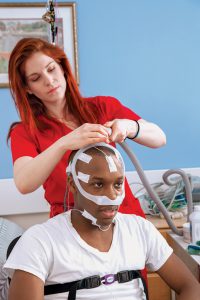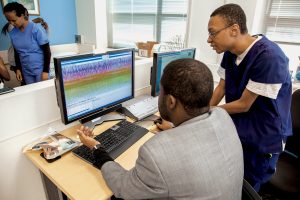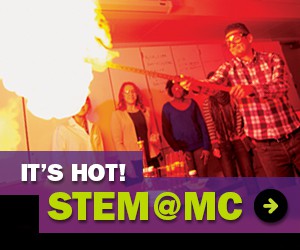A Wake Up Call for the Sleep Deprived
 Between 50 and 70 million US adults have sleep or wakefulness disorders, according to the Centers for Disease Control (CDC). Moreover, studies at the National Institutes of Health show people whose sleep sessions are irregular or short are more likely to develop diseases that can lead to an early death, including heart disease, stroke, diabetes, high blood pressure, Alzheimer’s disease, depression, post-traumatic stress disorder, and anxiety.
Between 50 and 70 million US adults have sleep or wakefulness disorders, according to the Centers for Disease Control (CDC). Moreover, studies at the National Institutes of Health show people whose sleep sessions are irregular or short are more likely to develop diseases that can lead to an early death, including heart disease, stroke, diabetes, high blood pressure, Alzheimer’s disease, depression, post-traumatic stress disorder, and anxiety.
There is increasing evidence about how pervasive the problem is. According to the CDC, nearly one-third of all Americans get fewer than seven hours of sleep a night. And with the growing dependence on mobile electronic devices and video games, sleeplessness starts early: nearly 70 percent of high school students are not getting enough sleep on school nights.
“Of the 80-plus sleep-related disorders, the most common are insomnia, obstructive sleep apnea, periodic limb movement disorders, and restless leg syndrome,” says Jomo Nkunika, coordinator of Montgomery College’s polysomnography (sleep medicine) technology program and an adjunct faculty member. Nkunika said these sleep disorders are evaluated—and often corrected—at an American Academy of Sleep Medicine-accredited sleep laboratory.
There are more than 2,500 certified sleep centers in the United States today—a nearly five-fold increase over 10 years. Consequently, the demand for qualified polysomnographic technologists also has increased. In an effort to meet this demand, Montgomery College created its one-year polysomnography certificate program in 2009.

Julia Spenadel practices set up and hook up procedures for a baseline sleep study on fellow student Brandon Honemond.
“The demand for qualified polysomnographic technologists in the Washington metropolitan area was so great, we had to create a robust program that would prepare students to hit the ground running in a short amount of time,” said Nkunika. The 34-credit program includes courses in anatomy and physiology, sleep disorders, computer applications, psychology, medical terminology, and hands-on lab courses. Students then complete clinical rotations at hospitals and sleep centers in Maryland, Virginia, and the District of Columbia.
Nkunika says MC’s polysomnography students are well prepared to enter the field. About 85 percent of the students pass the Registered Polysomnographic Technologist credentialing exam delivered by the Board of Registered Polysomnographic Technologists (BRPT). Once credentialed, polysomnographic technologists officially can start working in the sleep medicine field.
One of MC’s aspiring sleep technologists is Julia Spenadel, a 25-year-old Bethesda resident. Spenadel, who went to art school, then enrolled in University of Maryland’s public health program, wanted a field with a “better financial outcome.” “I knew I wanted to stay in the health field,” she says, “so I Googled what health professions were lucrative, and discovered polysomnography.”
The US Bureau of Labor Statistics (BLS) doesn’t provide employment data specifically for sleep technicians, but it does profile related fields. According to the BLS, jobs for medical and clinical laboratory technicians are expected to increase 18 percent between 2014 and 2024, which is about as fast as average. Additionally, PayScale.com reported that registered polysomnographic technologists earned a median salary of $50,046 as of 2016.
Spenadel will complete her credit courses, as well as clinical rotations at MedStar National Rehabilitation Hospital, the Washington DC Veterans Administration Hospital, and Children’s National Medical Center this spring. “Very often, students are hired by one of the hospitals where they interned,” she said. She said MC’s class schedule is a perfect fit for her because she is a makeup artist on the weekends. “All of our classes start at 4 p.m. and run about four hours. Then we go to our clinical rotations a couple nights a week.”
“Sleep affects almost every tissue in our bodies,” writes Dr. Michael Twery, a sleep
expert at NIH. “It affects growth and stress hormones, our immune system, appetite, breathing, blood pressure, and cardiovascular health.” 1
At a sleep center, patients arrive at a certain time in the evening. A polysomnographic technologist explains the procedure and equipment that will be used for the study and answers patient questions. Next, the polysomnographic technologist attaches nearly two dozen metal sensors, or electrodes, to the skin on the head and body with a mild adhesive.
The sensors on the scalp measure the brain’s activity; others glued to the collar bone and chest measure heart rate and rhythm; some on the leg and chin monitor muscle movement; more in the nose and mouth monitor airflow; those placed near the eyes monitor eye movement, which is important for detecting rapid eye movement (REM) sleep. According to NIH research, during REM sleep, the brain and body are energized and dreaming occurs. REM is thought to be involved in the process of storing memories, learning, and balancing mood, although the exact mechanisms are not well understood. Two belts—on the chest and abdomen—monitor movement and help understand breathing.
Additionally, a polysomnographic technologist places an oxygen sensor on the patient’s fingertip to measure oxygen levels and tapes a microphone near the patient’s throat to monitor snoring. Many sleep study centers are equipped with video cameras that record body movement during sleep.

Professor Jomo Nkunika shows polysomnography student Lawrence Fells (right) how to properly calibrate sleep study software.
The data obtained in a sleep study is extensive. An average sleep study generates 800 to 1,000 pages of information. During the day, a polysomnographic technician analyzes all of the data from the sleep study and compiles statistics from the various leads attached to the patient. This information includes how the patient was breathing, how steadily the patient slept, how often the patient woke up, whether or not the patient experienced neurological arousals due to breathing disorders, and other factors. The sleep center then forwards the report to the doctor for interpretation.
If the doctor determines that a patient has sleep apnea, the doctor most frequently will order a positive airway pressure device, or PAP machine. A PAP machine uses air pressure to open the airway while a patient is sleeping to prevent the airway restrictions that lead to the decreased oxygen levels and brain arousal associated with sleep apnea. The College’s polysomnography students train to fit patients with PAP interfaces and machines at follow-up visits to the sleep center. Doctors also treat sleep apnea with lifestyle changes, mouthpieces, and surgery. Medicines typically are not used to treat the condition.
Nkunika, who is also a practicing polysomnographic technologist, clinical sleep heath specialist, and board member of the BRPT, says doctors may treat issues like high blood pressure with medicine, but if they do not treat the underlying problem—sleep apnea—patients may continue to have high blood pressure. He said there are several signs that should alert someone that they need a sleep study. “If your partner tells you that you are snoring excessively, you may have sleep apnea,” he says. “You should visit your physician and speak candidly about the problem.” Nuknika also says people who suffer from fatigue, excessive daytime drowsiness, morning headaches, dry mouth, hydrosis (excessive sweating), and those who have a larger neck size (men, greater than or equal to 17 inches; women, greater than or equal to 16 inches)2 may also be at risk for sleep apnea.
According to researchers at NIH, sleep deprivation is a common public health problem in the United States. In fact, the National Highway Traffic Safety Administration conservatively estimates that 100,000 police-reported crashes are the direct result of driver fatigue each year. This results in an estimated 1,550 deaths, 71,000 injuries, and $12.5 billion in monetary losses. These figures may be the tip of the iceberg, since currently it is difficult to attribute crashes to sleepiness alone. Although many people believe they can shortchange themselves on sleep and still be okay, the risks associated with sleep—or lack thereof—should not be taken lightly.
—Jill Fitzgerald
Photography by Grace Gladhill ’05
Sources:
1 The Benefits of Slumber: Why You Need a Good Night’s Sleep
NIH News in Health, April 2013
2 Sleep Apnea: Is Your Patient at Risk?
National Institutes of Health, National Heart, Lung, and Blood Institute, 1995


